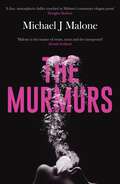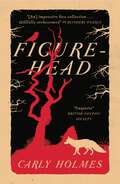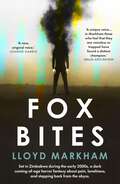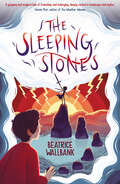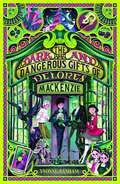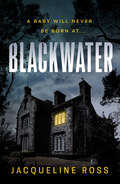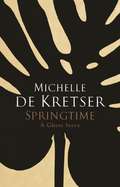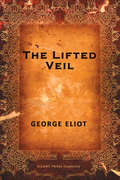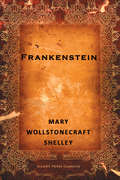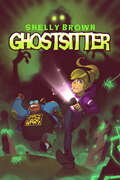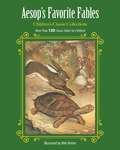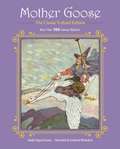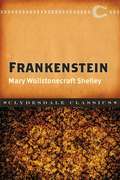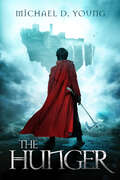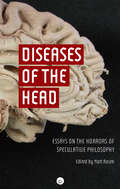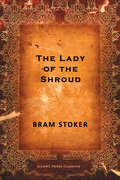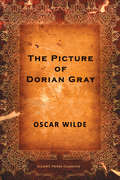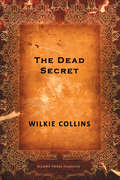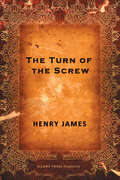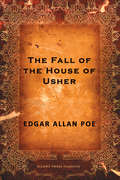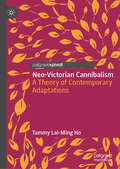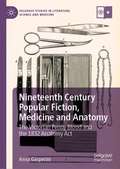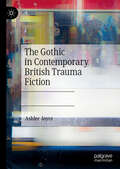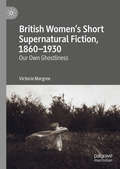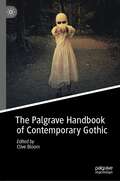- Table View
- List View
The Murmurs: The most compulsive, chilling gothic thriller you’ll read this year… (The\annie Jackson Mysteries Ser.)
by Michael J. MaloneA young woman starts experiencing terrifying premonitions of people dying, as it becomes clear that a family curse known only as The Murmurs has begun, and a long-forgotten crime is about to be unearthed…On the first morning of her new job at Heartfield House, a care home for the elderly, Annie Jackson wakens from a terrifying dream. And when she arrives at the home, she knows that the first old man she meets is going to die. How she knows this is a terrifying mystery, but it is the start of horrifying premonitions … a rekindling of the curse that has trickled through generations of women in her family – a wicked gift known only as ‘the murmurs’…With its reappearance comes an old, forgotten fear that is about to grip Annie Jackson.And this time, it will never let go…A compulsive gothic thriller and a spellbinding supernatural mystery about secrets and small communities, about faith, courage and self-preservation, The Murmurs is a startling and compulsive read from one of Scotland’s finest authors.
Figurehead
by Carly Holmes'(An) impressive first collection ... skilfully orchestrated' – Publishers Weekly "starred" review 'This truly is quality literature of our modern times' – The British Fantasy Society 'To read Carly Holmes is to be enchanted. Luscious, flowing prose that is never afraid to peer into the wild' – Angela Readman Beneath her soft skin covering, my mother was once made of twigs and branches. Sometimes in the autumn I swear there was a gleam of berry in her eye, a sloe-shine peep between the thorny tangle of her lashes. In this debut collection of stories Carly Holmes peers into every corner of the strange fiction genre: from rural gothic through to traditional ghost stories and the uncanny. Mothers turn into trees when the sun goes down; Russian Dolls mourn their missing sisters in rotting houses; men offer sacrifices to the monsters who embody their inner wildness; and murderous demons protect young girls' virginity. Ranging from flash fiction to novelette, these stories are in turn chilling, playful, and melancholy. The bonds of family and of community, both in their fracturing and their healing states, the uneasy relationship between living in the present and yearning for the past, are themes that thread their way through Figurehead. Every tale is rich with landscapes haunted by loss and longing.
Fox Bites
by Lloyd Markham'a new original voice' – Joanne Harris 'A unique voice... in Markham those who feel that they are voiceless or trapped have found a distinct champion.' – Wales Arts Review When Taban wishes for the world to end something out there . . . hears him. Soon the young boy is being stalked by a fox whose salivating jaws drag him into strange dreams. Dreams where he is a revolutionary with ancient psychic powers fighting against a tyrannical regime. He awakes with glowing scars that only he can see and the lingering embers of telekinetic abilities. Honing this flicker of power over years he plots revenge on the bullies who've abused him. In exchange he will become the conduit for the world's end. But what if he changes his mind? Surely we can all come back from the edge? Can we? Set in Zimbabwe during the early 2000s, amidst a backdrop of political turmoil, Fox Bites is a dark coming-of-age horror fantasy about pain, loneliness, and stepping back from the abyss.
The Sleeping Stones
by Beatrice WallbankGruff lives on a small island full of legends, off the Welsh coast. Strange things start happening after Matylda and her family arrive: islanders finding themselves irresistibly drawn to the Sleeping Stones, a line of rocks like natural stepping stones out to sea... Gruff and Mat soon realise they must risk everything to save each other and their community from a terrifying storm driven by an ancient, magic anger.
The Dark and Dangerous Gifts of Delores Mackenzie
by Yvonne BanhamSent into the care of the mysterious Uncles in Edinburgh’s Old Town, Delores Mackenzie must learn to control her paranormal gifts without crossing the accepted bounds of paranormal activity and angering her strange new housemates. But when a sinister apparition appears and threatens the lives of her friends, can Delores really push back the dead?
Blackwater: A baby will never be born at Blackwater
by Jacqueline RossThere is much that heavily pregnant Grace still doesn't know about her new husband King's background. So, when word comes that King's father is dying, Grace is eager to accompany him to his childhood home, Blackwater, located in a remote part of Tasmania.Things go badly from the start. The house is in terrible repair, King's dying father yells at Grace to leave and King's twin sister, Ruth, seems disturbed by Grace's presence. After his father's death, King convinces Grace they must stay and help Ruth settle the estate, but as time stretches on he grows strange and distant. When Grace learns about Blackwater's dark history, she begins to fear that it is the house itself exerting an evil influence on her husband.Feeling increasingly isolated, and with the birth of her child looming, Grace knows she must uncover the secrets of Blackwater if she hopes to free her family from its grip.A riveting story that twists present with a horrifying past. Blackwater is Australian Gothic at its finest. Anna SnoekstraA compelling, atmospheric and immensely satisfying novel containing echoes of Stephen King and Daphne du Maurier. Chris Womersley
Springtime: A Ghost Story
by Michelle de KretserPicking up her pace, Frances saw a woman in the leaf-hung depths of the garden. She wore a long pink dress and a wide hat, and her skin was a creamy white. There came upon Frances a sensation that sometimes overtook her when she was looking at a painting: space was foreshortened, time stood still.When Frances met Charlie at a party in Melbourne he was married with a young son.Now she and Charlie live in Sydney with her rescue dog Rod and an unshakeable sense that they have tipped the world on its axis. They are still getting their bearings - of each other and of their adopted city. Everything is alien, unfamiliar, exotic: haunting, even.Worlds of meaning spin out of perfectly chosen words in this rare, beguiling and brilliant ghost story by Miles Franklin Literary Award-winning writer Michelle de Kretser.
The Lifted Veil
by George EliotQuite unlike the realistic fiction for which Eliot is best known, The Lifted Veil explores themes of extrasensory perception, the essence of physical life, possible life after death, and the power of fate. The novella is a significant part of the Victorian tradition of horror fiction.
Frankenstein
by Mary ShelleyThe eccentric Dr. Victor Frankenstein creates life from assembled body parts, only to realise his creature is an abomination. He casts the monster out, deeply regretting his work. When the monster, despondent at his creator's disgust, attempts to befriend humans, he is rejected – a rejection that leads to violence and great loss for Frankenstein. A thematic indictment of blind ambition and man's fear of the unknown, Frankenstein endures as a classic piece of English literature and the inspiration for countless film and television adaptations.
Ghostsitter
by Shelly BrownJoin two ghost-seeing friends, Tiffany and Justin, as they strive to solve mysteries, fit in at school, and help troubled ghosts seeking peace in this thrilling middle grade adventure.
Aesop's Favorite Fables: More Than 130 Classic Fables for Children!
by Milo WinterRacehorse Publishing’s Children’s Classic Collections is a new series that offers readers timeless compilations of children’s literature. Handsomely packaged and affordable, this new series aims to revitalize these enchanting works and continue the tradition of sharing them with the next generation.Passed down for thousands of years, Aesop’s Fables is a collection of moral stories by the famed storyteller from ancient Greece. Reprinted and translated thousands of times over the past two millennia, this collection represents some of the most widely known and famous children’s literature. Many of these fables bestow human traits upon animal characters and place them in human situations to highlight desirable and less desirable traits. Their intent, through the telling of these tales, is to teach readers important moral lessons such as "Self-help is the best help” or "Do not attempt too much all at once.”Accompanied by beautiful color illustrations by renowned illustrator Milo Winter, this premiere collection of Aesop’s Favorite Fables is sure to ignite young imaginations and educate readers about virtue, kindness, integrity, problem-solving, happiness, and what it means to be human.
Mother Goose: More Than 100 Famous Rhymes!
by Eulalie Osgood Grover Frederick RichardsonRacehorse Publishing’s Quintessential Children’s Classics series is a collection of timeless children’s literature. Handsomely packaged and affordable, this new series aims to revitalize these enchanting works, and continue the tradition of sharing them with the next generation of readers.Flash back to your childhood. We all remember hearing the remarkable, rhyming tales from a mystery woman known only by the name "Mother Goose.” Having been reprinted hundreds of times and passed down from generation to generation, Mother Goose’s stories are some of the most popular children’s poetry in the world.Originally made popular in the 17th century, these rhymes were on the forefront of fairy tale literature, and are often cited as the beginning of the genre. Now, these nursery rhymes are made available again in this stunning re-packaging of the classic Volland edition. This edition includes over one hundred and ten of Mother Goose’s most famous nursery rhymes, a foreword, and full color illustrations on every page by renowned illustrator Frederick Richardson.
Frankenstein: Or The Modern Prometheus
by Mary Shelley"Enduring power.” -The New York TimesPackaged in handsome and affordable trade editions, Clydesdale Classics is a new series of essential literary works. The series features literary phenomena with influence and themes so great that, after their publication, they changed literature forever. From the musings of literary geniuses such as Mark Twain in The Adventures of Huckleberry Finn, to the striking personal narratives from Harriet Jacobs in Incidents in the Life of a Slave Girl, this new series is a comprehensive collection of our literary history through the words of the exceptional few.Frankenstein, or The Modern Prometheus, is often referred to as one the most important literary works of all time. Having been adapted and reprinted thousands of times, and often cited as the birth of the gothic novel and the science fiction genre, Frankenstein has captivated readers for centuries. It is the haunting tale of Victor Frankenstein, a young scientist who creates a grotesque and cognizant being through a scientific experiment. "The monster,” as it’s frequently referred to throughout the novel, consists of sewn body parts from multiple cadavers being used for scientific research. On a dark, stormy night, the creature is brought to life by being shocked with an electrical current harnessed from a lightning storm. The novel explores scientific practices such as galvanism, as well as the ethical repercussions of bringing the deceased back to life.With its grim, but gripping narrative, Frankenstein is the classic story of life and death, humanity and monstrosity, and blurring the lines in between.
The Hunger
by Michael D. YoungAzil leads a quiet, scholary life until a failed assassination attempt and a mysterious stranger push him into a quest to fulfill a world-saving prophecy. Fans of high fantasy will be enthralled by volatile magic, clan politics, and a reluctant adventurer&’s journey through a land ruled by hunger.
Diseases of the Head: Essays on the Horrors of Speculative Philosophy
by Matt RosenDiseases of the Head is an anthology of essays from contemporary philosophers, artists, and writers working at the crossroads of speculative philosophy and speculative horror. At once a compendium of multivocal endeavors, a breviary of supposedly illicit ponderings, and a travelogue of philosophical exploration, this collection centers itself on the place at which philosophy and horror meet. Employing rigorous analysis, incisive experimentation, and novel invention, this anthology asks about the use that speculation can make of horror and horror of speculation, about whether philosophy is fictional or fiction philosophical, and about the relationship between horror, the exigencies of our world and time, and the future developments that may await us in philosophy itself. From philosophers working on horrific themes, to horror writers influenced by heresies in the wake of post-Kantianism, to artists engaged in projects that address monstrosity and alienation, Diseases of the Head aims at nothing less than a speculative coup d'état. Refusing both total negation and absolute affirmation, refusing to deny everything or account for everything, refusing the posture of critique and the posture of all-encompassing unification, this collection of essays aims at exposition and construction, analysis and creation – it desires to fight for some thing, but not everything, and not nothing. And it desires, most of all, to speak from the position of its own insufficiency, its own partiality, its own under-determinacy, which is always indicative of the practice of thinking, of speculation. Considering themes of anonymity, otherness and alterity, the gothic, extinction and the world without us, the end times, the apocalypse, the ancient and the world before us, and the uncanny or unheimlich, among other motifs, this anthology seeks to articulate the cutting edge which can be found at the intersection of speculative philosophy and speculative horror.
The Lady of the Shroud
by Bram StokerThe Lady of the Shroud is a novel by Bram Stoker, published in 1909. The book is an epistolary novel, narrated in the first person via letters and diary extracts from various characters, but mainly Rupert. The initial sections, leading up to the reading of the uncle's will, told by other characters, suggest that Rupert is the black sheep of the family, and the conditions of having to live in the castle in the Blue Mountains for a year before he can permanently inherit the unexpectedly large million-pound estate suggest the uncle is somehow testing the heir. When an unexpected, mysterious women cloaked in a wet shroud appears, she changes Rupert's destiny forever.
The Picture of Dorian Gray
by Oscar WildeDorian Gray believes that the true value of life is revealed only in the pursuit of beauty. As a result, Dorian sells his soul so that a beautiful painting of him will age, while he remains forever young.
The Dead Secret
by Wilkie CollinsWarned by a servant to avoid a particular room in her ancestral home, Porthgenna Tower, a wealthy heiress searches the room only to discover a long-held secret that has the potential to strip her of her inheritance. But when Rosamund Treverton reveals the secret of her birth, she is surprised by the reactions of those closest to her.
The Turn of the Screw
by Henry JamesGiven charge of two young children, Flora and Miles, by their uncle, a young governess takes up their care at a house in the country. But the governess's pleasure in her young charges and in the idyllic countryside soon turns to fear and panic when she comes to suspect that the house is haunted. And when the children are revealed to be aware of the presence, the governess fears -quite rightly - for their safety as well. The Turn of the Screw, a part of gothic and ghost story genres, was originally published in 1898. Many critics have tried to determine the exact nature of the evil hinted at by the story. However, others have argued that the brilliance of the novella results from its ability to create an intimate sense of confusion and suspense within the reader.
The Fall of the House of Usher
by Edgar Allan PoeThe fate of the Usher ancestral home rests on the heads of Roderick and Madeline Usher—siblings afflicted with psychological illnesses that will prove to be their undoing. A master of the mysterious and the macabre, Edgar Allan Poe's short stories explore the human psyche. "The Fall of the House of Usher" is considered to be one of the author's most famous works, and is a masterpiece of American Gothic literature.
Neo-Victorian Cannibalism: A Theory of Contemporary Adaptations
by Tammy Lai-Ming HoThis Pivot examines a body of contemporary neo-Victorian novels whose uneasy relationship with the past can be theorised in terms of aggressive eating, including cannibalism. Not only is the imagery of eating repeatedly used by critics to comprehend neo-Victorian literature, the theme of cannibalism itself also appears overtly or implicitly in a number of the novels and their Victorian prototypes, thereby mirroring the cannibalistic relationship between the contemporary and the Victorian. Tammy Lai-Ming Ho argues that aggressive eating or cannibalism can be seen as a pathological and defining characteristic of neo-Victorian fiction, demonstrating how cannibalism provides a framework for understanding the genre’s origin, its conflicted, ambivalent and violent relationship with its Victorian predecessors and the grotesque and gothic effects that it generates in its fiction.
Nineteenth Century Popular Fiction, Medicine and Anatomy: The Victorian Penny Blood and the 1832 Anatomy Act (Palgrave Studies in Literature, Science and Medicine)
by Anna GasperiniThis book investigates the relationship between the fascinating and misunderstood penny blood, early Victorian popular fiction for the working class, and Victorian anatomy. In 1832, the controversial Anatomy Act sanctioned the use of the body of the pauper for teaching dissection to medical students, deeply affecting the Victorian poor. The ensuing decade, such famous penny bloods as Manuscripts from the Diary of a Physician, Varney the Vampyre, Sweeney Todd, and The Mysteries of London addressed issues of medical ethics, social power, and bodily agency. Challenging traditional views of penny bloods as a lowlier, un-readable genre, this book rereads these four narratives in the light of the 1832 Anatomy Act, putting them in dialogue with different popular artistic forms and literary genres, as well as with the spaces of death and dissection in Victorian London, exploring their role as channels for circulating discourses about anatomy and ethics among the Victorian poor.
The Gothic in Contemporary British Trauma Fiction
by Ashlee JoyceThis book examines the intersection of trauma and the Gothic in six contemporary British novels: Martin Amis’s London Fields, Margaret Drabble’s The Gates of Ivory, Ian McEwan’s Atonement, Pat Barker’s Regeneration and Double Vision, and Kazuo Ishiguro’s Never Let Me Go. In these works, the Gothic functions both as an expression of societal violence at the turn of the twenty-first century and as a response to the related crisis of representation brought about by the contemporary individual’s highly mediated and spectatorial relationship to this violence. By locating these six novels within the Gothic tradition, this work argues that each text, to borrow a term from Jacques Derrida, “participates” in the Gothic in ways that both uphold the paradigm of “unspeakability” that has come to dominate much trauma fiction, as well as push its boundaries to complicate how we think of the ethical relationship between witnessing and writing trauma.
British Women’s Short Supernatural Fiction, 1860–1930: Our Own Ghostliness
by Victoria MargreeThis book explores women’s short supernatural fiction between the emergence of first wave feminism and the post-suffrage period, arguing that while literary ghosts enabled an interrogation of women’s changing circumstances, ghosts could have both subversive and conservative implications. Haunted house narratives by Charlotte Riddell and Margaret Oliphant become troubled by uncanny reminders of the origins of middle-class wealth in domestic and foreign exploitation. Corpse-like revenants are deployed in Female Gothic tales by Mary Elizabeth Braddon and Edith Nesbit to interrogate masculine aestheticisation of female death. In the culturally-hybrid supernaturalism of Alice Perrin, the ‘Marriage Question’ migrates to colonial India, and psychoanalytically-informed stories by May Sinclair, Eleanor Scott and Violet Hunt explore just how far gender relations have really progressed in the post-First World War period. Study of the woman’s short story productively problematises literary histories about the “golden age” of the ghost story, and about the transition from Victorianism to modernism.
The Palgrave Handbook of Contemporary Gothic
by Clive Bloom“Simply put, there is absolutely nothing on the market with the range of ambition of this strikingly eclectic collection of essays. Not only is it impossible to imagine a more comprehensive view of the subject, most readers – even specialists in the subject – will find that there are elements of the Gothic genre here of which they were previously unaware.” - Barry Forshaw, Author of British Gothic Cinema and Sex and Film The Palgrave Handbook of Contemporary Gothic is the most comprehensive compendium of analytic essays on the modern Gothic now available, covering the vast and highly significant period from 1918 to 2019. The Gothic sensibility, over 200 years old, embraces its dark past whilst anticipating the future. From demons and monsters to post- apocalyptic fears and ecological fantasies, Gothic is thriving as never before in the arts and in popular culture. This volume is made up of 62 comprehensive chapters with notes and extended bibliographies contributed by scholars from around the world. The chapters are written not only for those engaged in academic research but also to be accessible to students and dedicated followers of the genre. Each chapter is packed with analysis of the Gothic in both theory and practice, as the genre has mutated and spread over the last hundred years. Starting in 1918 with the impact of film on the genre's development, and moving through its many and varied international incarnations, each chapter chronicles the history of the gothic milieu from the movies to gaming platforms and internet memes, television and theatre. The volume also looks at how Gothic intersects with fashion, music and popular culture: a multi-layered, multi-ethnic, even a trans-gendered experience as we move into the twenty first century.
